Vinyl flooring is a durable and water-resistant multi-layer PVC (polyvinyl chloride) based floor covering. This type of flooring has many different names: vinyl flooring, vinyl tiles, vinyl laminate, PVC tiles, quartz vinyl floor tiles, LVT (luxury vinyl tiles), etc., which are all essentially the same thing.
Go to the catalog

Vinyl flooring in its modern form appeared relatively recently - several decades ago. Now vinyl flooring is actively gaining its place in residential and public rooms, its market share is increasing due to its unique characteristics. Let's have a closer look at what it is and what vinyl floors are.
Please note that this article is specifically about multi-layer modular vinyl flooring (LVT), which is used both for the home or flat and in public spaces. There is also vinyl that designed for large construction projects, it comes in rolls and the structure can be homogeneous, which is a homogeneous single layer, or heterogeneous, consisting of several layers. Such vinyl is often named as commercial vinyl.
Structure of vinyl flooring
It is a multi-layer floor covering, just like laminate flooring. The quantity of layers in the structure may differ, depending on the manufacturer. But there are definitely some:
- PVC backing, which can be reinforced with glass fiber or quartz sand (hereof the name quartz vinyl tile) - responsible for durability, helps to avoid dents from furniture legs or heels;
- decorative layer, which is responsible for the appearance;
- a protective layer that ensures the wear resistance of the coating and easy maintenance.

Luxury vinyl tile structure on the example of Moduleo (Belgium) vinyl flooring.
Appearance of vinyl flooring
One of the main advantages of vinyl flooring is its variety and endless design possibilities. Vinyl flooring can imitate different types of wood (oak, ash, pine, walnut), and such richness of shades is not always available even in parquet flooring lines, different types of stone (slate, travertine, marble, etc.), tiles, concrete, textiles and other textures.
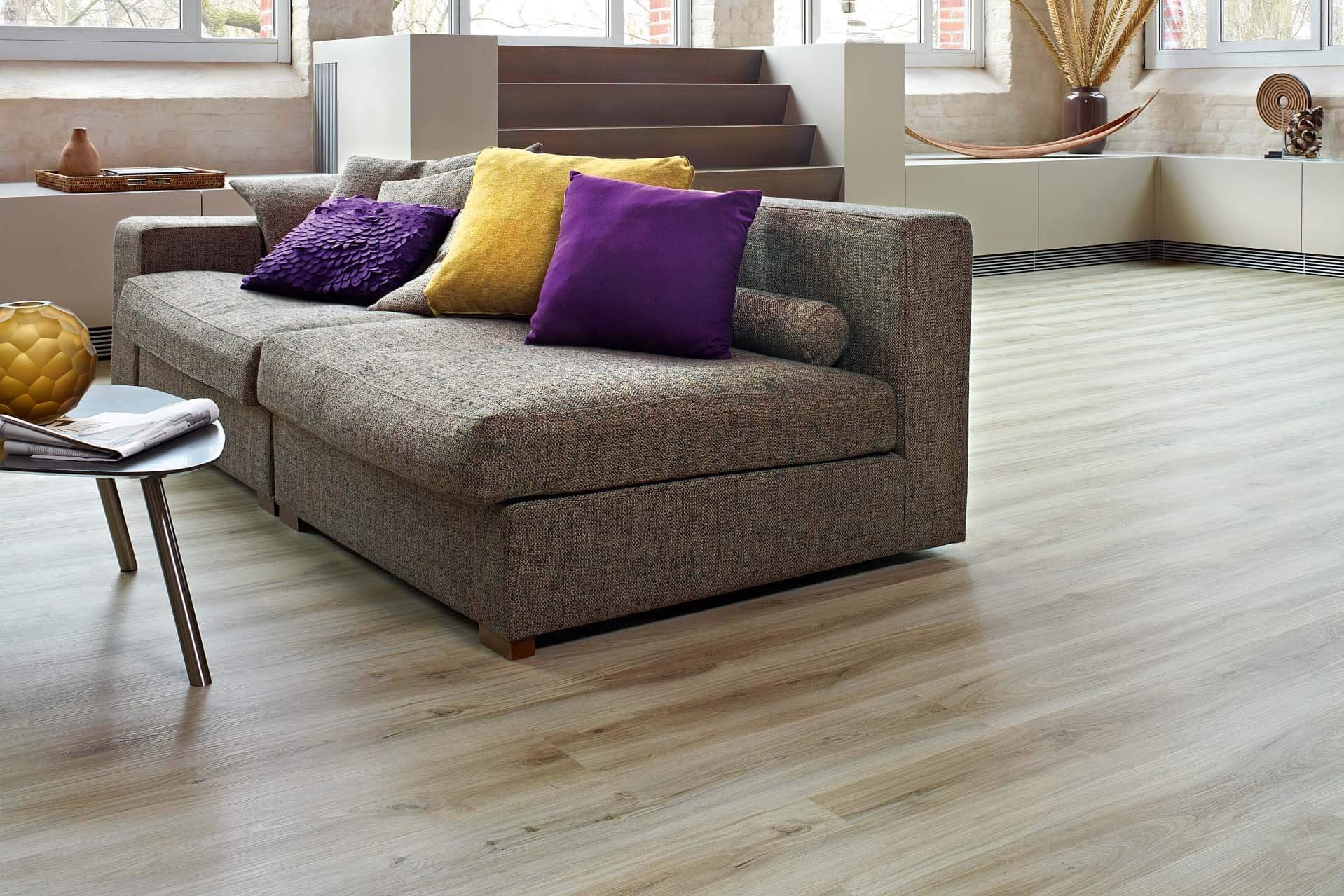

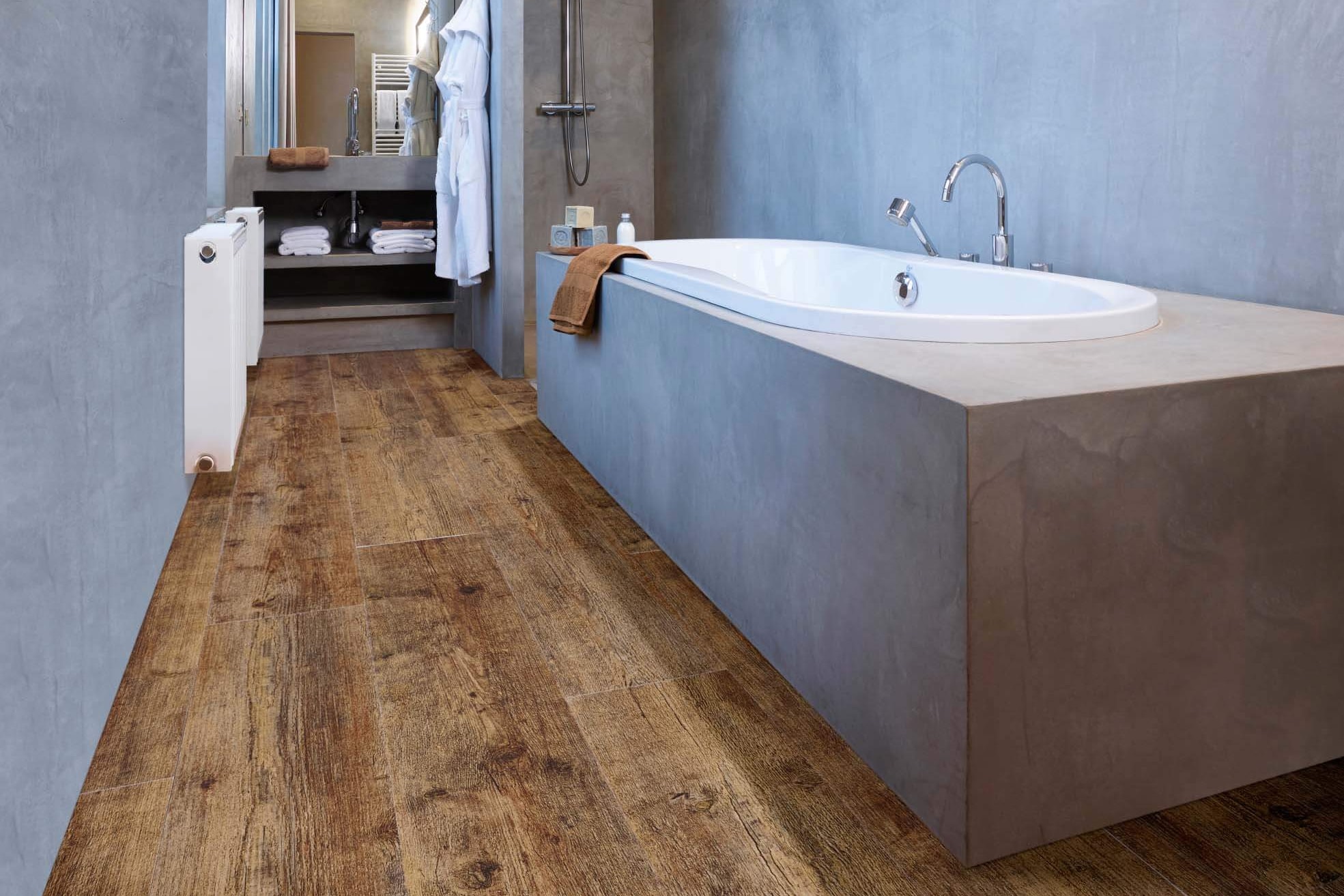
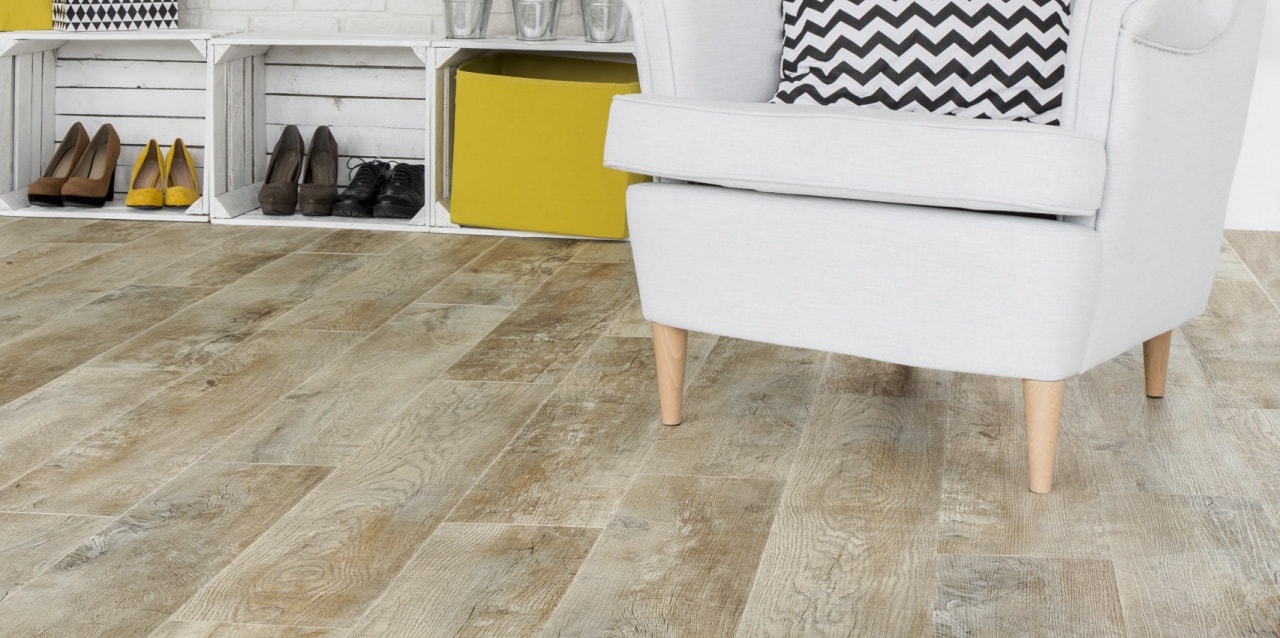


By texture, vinyl floors could also be smooth, embossed, rough and woven. One of the most spectacular vinyl surface is embossed in register. This means that the texture of the surface completely coincides with the pattern of the decorative layer. Thanks to this it is possible to achieve the most accurate imitation of parquet or stone tiles.
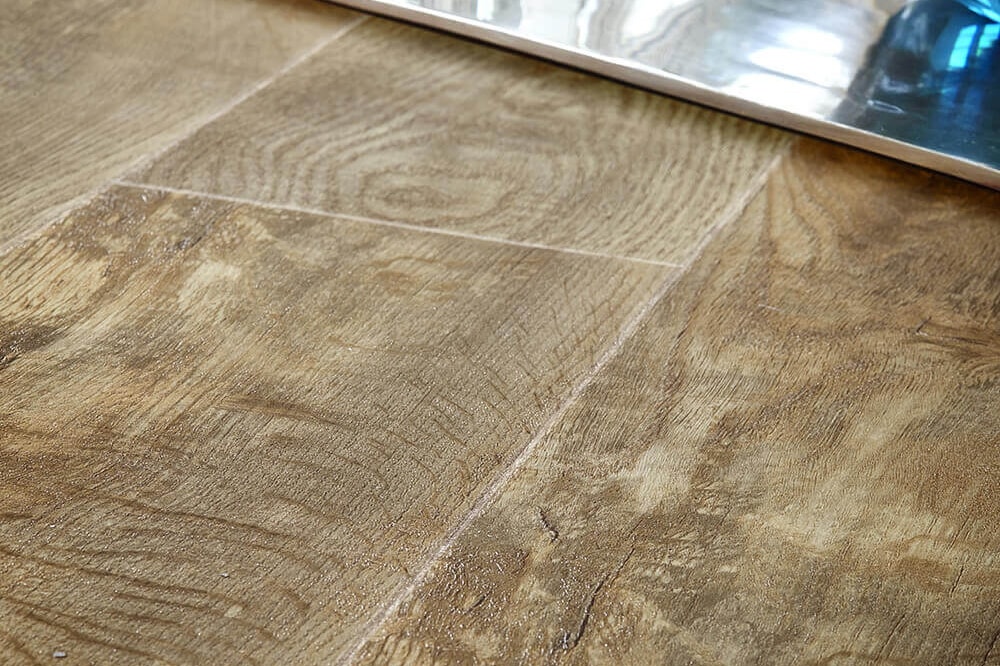
They also vary in gloss, from completely matte to deep glossy.
Vinyl flooring is easy to cut, and it is possible to combine ready-made modules of different shapes directly on site, which gives a wide range of possibilities for realizing your own design ideas.



Types of vinyl flooring
Vinyl flooring is varied in several ways.
According to the method of installation vinyl can be:
- Adhesive – laid with adhesive only.
- Locked – installed with locking joints, like laminate or parquet flooring.
According to format, there are:
- Roll is suitable for large areas. The size of rolls is approximately 2x25 meters. Rolled vinyl is installed only on adhesive. This is a separate category of vinyl flooring - commercial vinyl, which we mentioned at the beginning of the article.
- Plank is mainly used for vinyl flooring with wood decor. Such vinyl is often referred to as vinyl laminate. The dimensions vary between manufacturers, with a width of approximately 150-190 mm and a length of 900-1300 mm.
- Tiles are most often square or rectangular, in designer collections they are in the form of various polygons, which can be combined and create their own patterns based on the available modules. The sizes vary among manufacturers. For example, Moduleo tile 655x324 mm, Tarkett tile 457x457 mm, QuickStep tile 1300x320 mm.
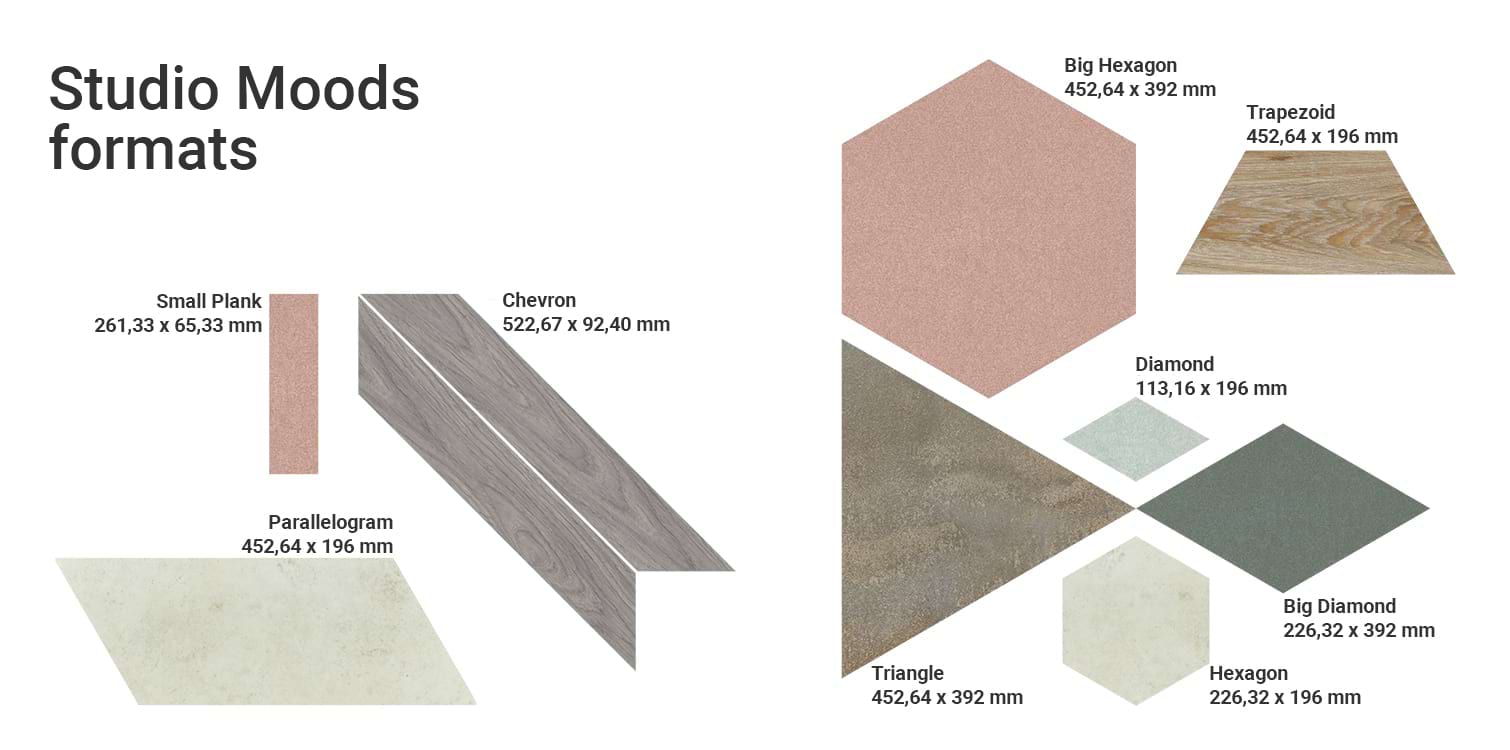
Variety of formats with the Moduleo MOODS collection as an example
Vinyl categorized by purpose according to its abrasion resistance:
- Domestic – 21-23 class, suitable for laying in residential areas with low load.
- Commercial – 31-34 class, suitable for public areas with high traffic (restaurants, cafes, offices, hotels, showrooms, shops, etc.).
- Industrial – 41-43 class, suitable for commercial and industrial areas with intensive floor loading.
hey differ in the thickness of the wear layer and fire safety class.
Advantages of vinyl flooring
We've told you about the exterior variety, but vinyl flooring has many other advantages.
- Moisture resistant. Have you spilled anything on the floor? No need to worry: vinyl flooring isn’t afraid of moisture. Feel free to install it in the kitchen and even in the bathroom.
- Wear-resistant. The upper polyurethane layer protects the surface of vinyl flooring from abrasion, scratches, burnout, so the floor looks like new for a long time. Depending on the class and intensity of use, vinyl flooring can last up to 20- 25 years.
- Durable and resilient. Vinyl flooring is quite rigid and elastic at the same time. They are pleasant to walk on because they are slightly "springy", but at the same time, there is no fear of dents from furniture legs, heels or wheeled chairs.
- Quiet. The surface of vinyl flooring is not as hard as laminate or tile, so it absorbs noise and dampens the sound of footsteps. This creates acoustic comfort for both of you and your downstairs neighbors.
- Warm. Vinyl flooring acts as an insulator, it keeps out the cold from the concrete screed and leaves all the heat in the room. So you can walk on the floor barefoot and be safe when children play on the floor.
- Resistant to temperature fluctuations. This makes vinyl flooring suitable for underfloor heating.
- Non-slip. Vinyl flooring has good anti-slip properties, even when wet. This is especially important when there are children or elderly people in the house.
- Safe. Quality of vinyl floors from trusted manufacturers is safe for both humans and the environment. They are composed of recyclable raw materials and do not contain or emit harmful compounds. Before buying, ask for environmental certificates to make sure in purchasing safe material. In addition, no harmful microorganisms can survive on vinyl floors if hygiene is maintained properly, so they are suitable for people with allergies.
- Easy to maintain. Regular damp mopping is enough to keep it clean. Vinyl flooring does not attract dust, it is not afraid to spill coffee or red wine on it - it can be cleaned perfectly with any neutral detergent.
- Anti-static. You can forget about unexpected electric shocks when touching conductive objects. Therefore, vinyl flooring can be safely used for offices, shops and other public spaces.
Are there any downsides? There aren't many.
- Vinyl flooring is quite thin (2-5 mm), so the subfloor must be perfectly flat. This is sometimes difficult and expensive to achieve.
- Vinyl floors are damaged by rubber. Do not use furniture with rubber wheels and feet or rubberized mats.
Mounting
You can choose your installation method and buy the appropriate type of flooring: either lockable for underlay or vinyl for adhesive installation.
Like laminate flooring, vinyl flooring with interlocking joints is easy and fast enough to install even by yourself. But it is better to entrust the installation to professionals.
Vinyl flooring can be laid on any type of subfloor: concrete, tile, wood, i.e. it can be laid on old flooring. The main thing is that the subfloor should be level (no height differences), dry and clean.
Choose vinyl flooring in the catalogue on the website or in our showroom.
Vinyl flooring












